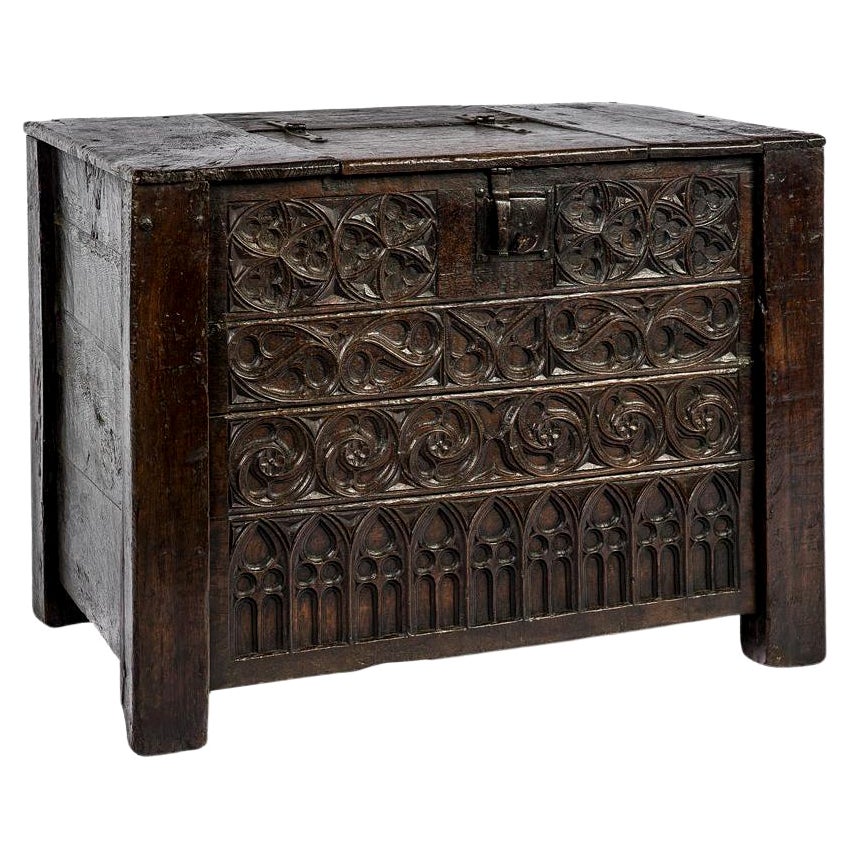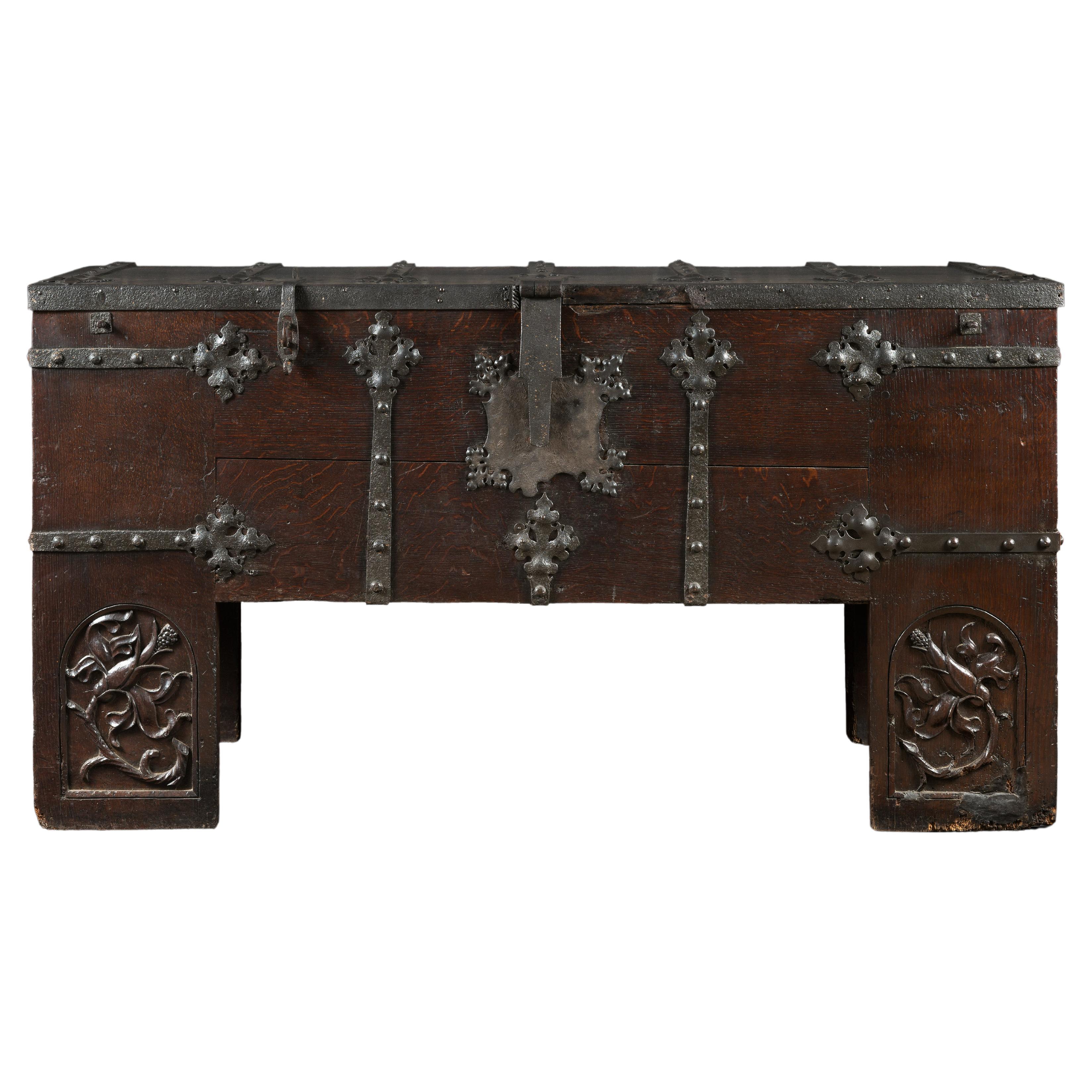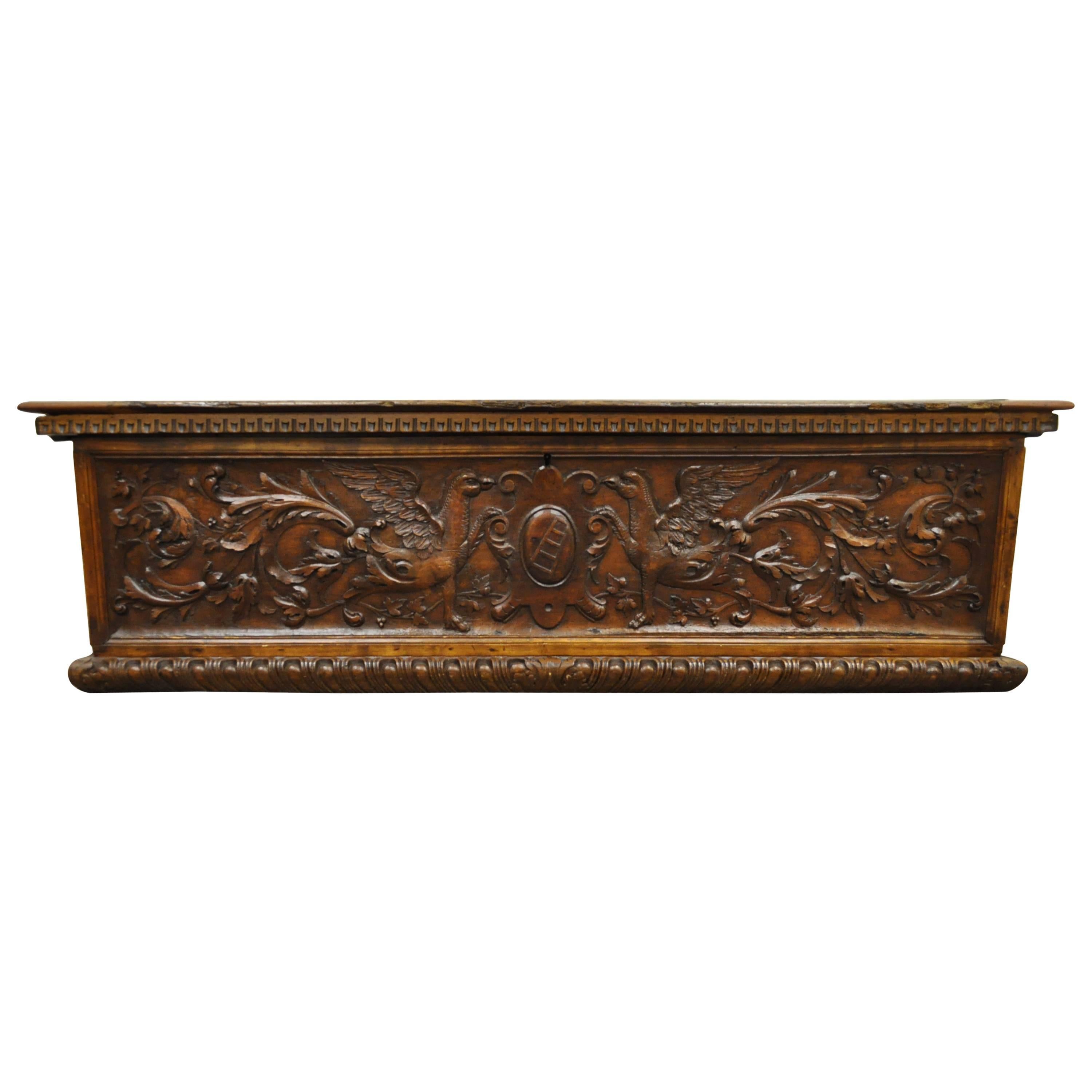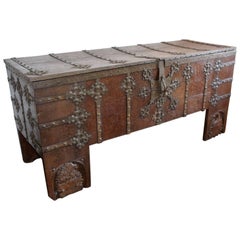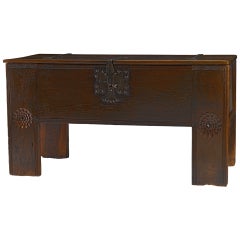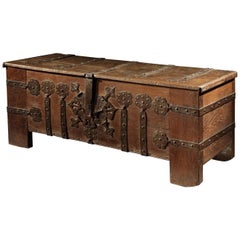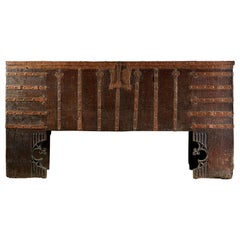
Rare 15th Century German Gothic Chest or Stollentruhe, Westphalia
View Similar Items
Want more images or videos?
Request additional images or videos from the seller
1 of 5
Rare 15th Century German Gothic Chest or Stollentruhe, Westphalia
About the Item
- Dimensions:Height: 38.59 in (98 cm)Width: 74.81 in (190 cm)Depth: 26.38 in (67 cm)
- Style:Gothic (Of the Period)
- Materials and Techniques:
- Place of Origin:
- Period:
- Date of Manufacture:circa 1470-1500
- Condition:Replacements made: Very few parts of the iron bands are of later date. Wear consistent with age and use. Minor losses. Key missing, a few parts of the iron bands of later date.
- Seller Location:Worpswede / Bremen, DE
- Reference Number:Seller: 20631stDibs: LU981418484532
About the Seller
5.0
Recognized Seller
These prestigious sellers are industry leaders and represent the highest echelon for item quality and design.
Established in 1979
1stDibs seller since 2013
Typical response time: 15 hours
More From This SellerView All
- Rare Late Medieval 16th Century German Wrought Iron Oak Chest or StollentruheLocated in Worpswede / Bremen, DEA very impressive Westphalian Gothic chest or ‚Stollentruhe’, Westphalia, Germany, circa 1500-1550. Wrought iron mounted oak, partially carved. The monumental rectangular standing chest with full-height stiles, extensively mounted with wrought ironwork straps terminating in quatrefoil finials which ’wrap’ around the chest edges. These are fixed with convex head nails. The ironwork with some remains of an originally red painted surface. In addition, running along the edges of the lid at the front and sides is a plain iron band, close-nailed. The feet of the two front legs are finely carved on the front face, in low relief with a rectangular arched ’panel’ depicting on the left a lion, on the right a dragon holding each a coat of arms. Regarding the age of circa 500 years, this coffer is in exceptionally good condition, with only smaller restorations. Comparative literature • Baumeier, Stefan, Beschlagene Kisten; Die ältesten Truhen Westfalens, Essen, 2012. • Falke, Otto von, Deutsche Möbel...Category
Antique 16th Century German Medieval Blanket Chests
MaterialsIron
- 17th Century German Iron-Mounted Oak Chest / Trunk "Stollentruhe"Located in Worpswede / Bremen, DEA 17th century German oak chest ("Stollentruhe") in the medieval/ Gothic tradition. The rectangular hinged top with three iron straps, enclosing a plain interior with one hinged smal...Category
Antique 17th Century German Baroque Commodes and Chests of Drawers
MaterialsOak
- Rare Victorian Mid-19th Century Gothic Revival Library Architects Plan ChestLocated in Worpswede / Bremen, DEA neo-gothic mid-19th century library plan chest having an arrangement of eleven short and three long drawers to one side, the other side with three short drawers above gothic style linen fold panelling, centred with the carved monogram ‘HP’, further matching panelling to the sides. A stunning plan chest of good propartions and with a nice patina. Provenance: Sherborne School, an independent school in north-west Dorset, England, established in 1550. Among the ‘Old Shirburnians’ are for example the writer John Cowper Powys, the actors Jeremy Irons und Charlie Cox, Chris Martin, leadsinger of the band Coldplay as well as Sheikh Tamim bin Hamad Al Thani...Category
Antique Mid-19th Century English Gothic Revival Commodes and Chests of D...
MaterialsOak
- Rare Pair of Early 19th Century Empire Bronze Vases, French or GermanLocated in Worpswede / Bremen, DEA rare and decorative pair of early 19th century Empire gilt and patinated bronze vases of campana form on a stepped square marble base. The everted egg-and-dart rim above a finely chased frieze depicting putti playing music. This or a similar pair of vases belonged to the collection of the Queen Louise of Prussia...Category
Antique 19th Century French Empire Vases
MaterialsMarble, Bronze
- Rare 18th Century German Faience Rococo Encrier Inkstand StockelsdorfLocated in Worpswede / Bremen, DEThe form of this rare encrier is based on the model of the known faience master Johann Georg Buchwald, who produced it first in the manufacture of Marieberg, later also in Eckernförd...Category
Antique Late 18th Century German Rococo Inkwells
MaterialsFaience
- Rare 17th Century Baroque Cabinet, South Germany Probably Augsburg, WunderkammerLocated in Worpswede / Bremen, DEA small architectural table cabinet, veneered in walnut and mulberry, the centre doors enclosing an arrangement of nine various sized drawers with bone knobs, behind a central door a...Category
Antique Late 17th Century German Baroque Cabinets
MaterialsBrass
You May Also Like
- Chest or Stollentruhe, Early 16th Century, German Gothic, Oak Chest, OriginalLocated in BUNGAY, SUFFOLKThis standing chest is of clamp-front construction, extensively decorated with long, ironwork straps with quatrefoil finials which ‘wrap’ around it, and has an ornate, central lockplate, and front legs with full, height stiles. The ironwork straps and finials are fixed with convex, headed nails: running along the front, five long straps; the two side straps; and the five straps on the top. On the chest front, centrally placed, is a large, iron lockplate with four outer, radiating spade finals in each corner and three, superimposed spade finials (a symbol of nobility) which are pierced with the initials ‘BB’. The lockplate receives a corresponding, external hasp fitted to the lid. Below the floor of the chest, the two front stile legs retain most of their original height. The lid is supported by substantial iron strap hinges that extend right down the back of the chest. Inside the chest at the left end is a shallow, oak till. Construction The chest is of joined, 'clamp-front' construction, reinforced by the nailed, iron mounts. In total it uses ten, oak boards which were riven and planed. The back and front are each formed from a large single plank held to the full height stiles by long, pegged tenons. The sides are also single boards joined into the stiles using long tenons held by dowels, and extend down below the chest bottom, concealing the ends of the bottom boards. The bottom consists of a single board cut into the sides and shallow rebates in the stiles. The front and back boards are dowelled into the bottom boards. The lid which overhangs the sides has a narrow cleat at each end, and consists of one wide plank which has bowed a little as a result of shrinkage. Ironwork : The wrought ironwork straps, lockplate, hasp and lock all appear all appear to be early, and of the same original manufacture and are fixed with convex headed nails. There is mild dark staining of the oak around the iron mounts, possibly because of low tannin content in the oak. Length 172 cm., 67 ¾ in., Height 71.5 cm., 28 ¼ in., Depth 63 cm., 24 ¾ in., Related to: No 900:2-1904 V&A Museum, London. Stadtmuseum Dusseldorf. Decorative Arts Museum Berlin. Museen Schleswig-Holstein & Hamburg. A related example featuring elaborately-carved feet and formerly in the Horsham Museum, West Sussex, sold at Christie's in 2010 for £97,250 and another example, again with carved feet sold at Sothebys in 2006 for £48,000. Literature: A similar example is illustrated in H. Lüttgens, Alt- Aachener Wohnkultur; Ein Rundgang durch ein altes Aachener Haus im Wohnstil des 18. Jahrhunderts, Aachen, n.d., ill. 12, and another comparable iron-bound chests...Category
Antique 16th Century German Gothic Blanket Chests
MaterialsOak
- Rare 15th Century Solid Oak Medieval Dutch Gothic Chest or TrunkLocated in Casteren, NLA very rare chest that was completely made of solid oak from the Netherlands middle ages. It is a joined chest with hand carved geometric gothic front panels. The ornaments used are typical Gothic ornaments such as trefoil, mouchette, and trace. This diminutive chest was probably made in the 15th century Netherlands. It has the typical construction of very early European furniture as is also seen on the German Stollentruhe. The chest has only a small lid with forged hinges...Category
Antique 15th Century and Earlier Dutch Gothic Blanket Chests
MaterialsWrought Iron
$9,586 Sale Price41% Off - Rare Gothic German Oak and Iron Chest Known as "Stollentruhe"Located in Saint-Ouen, FRThis large chest stands on high legs prolonging the lateral jambs. Presenting a sober and severe appearance the chest still belongs to the Medieval tradition. The piece is made from very high quality Hungarian wood. The jambs are joined to the facade and the lateral sides thanks to pegged mortise and tenon securing a great stability and squareness between each parts. The upper lid is made of two joined parts and so is the facade. The ironwork is present all over the surface of the chest and brings both an additional stability to the construction as well as a rich decor. The lid is secured with hinges. Hinges also run all over the chest in horizontal and vertical lines, ending in a floral motif. The hasp lock is also very ornamental. Those chests always present important proportions especially when they are made early in the period. This model was very popular in Germany and stayed in vogue until the 16th century. However the feet Gothic decor...Category
Antique 15th Century and Earlier German Gothic Blanket Chests
MaterialsWrought Iron
- Rare Late Medieval 16th Century German Wrought Iron Oak Chest or StollentruheLocated in Dallas, TXWe have the pleasure to present a rare late medieval 16th century German wrought iron oak chest or Stollentruhe. This is an early 16th century, ci...Category
Antique 16th Century German Gothic Blanket Chests
MaterialsWrought Iron
- 15th Century Italian Cassone ChestLocated in Saint-Ouen, FRThis chest stands on a high moulded plinth. It was made from a fine walnut wood and shows good traces of polychromy and gold leaf decor. The facade’s two panels, once colourful, ...Category
Antique 15th Century and Earlier Italian Gothic Blanket Chests
MaterialsWalnut
- A large and exceptional 15th c. Gothic leather and iron bound travelling chestLocated in PARIS, FRLarge leather and iron bound travel chest, very rare in its dimensions Late 15th century, Northern France Dimensions: h.103 cm, w. 178 cm, d. 77cm ( (H. 40.55 in, w. 70.08 in. d. 30.31 in) Our rectangular-shaped chest opens with a rounded lid. It is entirely covered in leather veneered on a wooden core, and decorated with wrought and crafted iron frames and hinges. It is garnished on all sides with iron hinges cut at the ends of Gothic trefoils. On the facade two lock plates with cut-out cloverleaf borders fitted with a hasp (one missing) attached to the cover. The iron bands serving as reinforcements on all sides as well as the central bands are decorated with plant and floral friezes and geometric patterns. These strips are attached to the wood using daisy-headed nails, typical of the French Renaissance. Given its size and loaded weight, our trunk has four carrying handles: two wrought iron side handles, but also two front handles. The interior has a stretched fabric dating from at least the 17th century, we find on the interior sides of the cover the original raspberry-colored vellum. This is a rare model in leather and iron of very large dimensions. Expensive materials, which were only used on small Gothic boxes (20 cm to 50 cm in length) like those in the public collections of many museums. Large chests exceeding 1 meter in length for the sake of economy and simplicity were generally made of wood sometimes covered with iron cladding. We found a large chest in the collections of the Metropolitan Museum of New York, but still smaller than ours (inv. 47.144, dim. H: 22 1/2" W: 50 1/2" D: 21"). There are also two similar large chests (with flat or slightly domed lids) in the collections of the Barcelona Leather...Category
Antique 15th Century and Earlier French Gothic Blanket Chests
MaterialsWrought Iron
Recently Viewed
View AllMore Ways To Browse
Shallow Chest
Officers Chest
Northern Europe Chest
Northern European Chest
Small Gothic Cabinet
Antique Clothing Iron
Gothic Wood Carving
Antique Wood Iron Board
Antique Chest Draws
Jewelry Cabinet Lock
Hasp Lock
Two Drawwer Chest
Medieval Textile
Money Chest
Merchant Chests
Swords Antique Weapons
Antique Merchants Chest
Antique Merchant Chest

